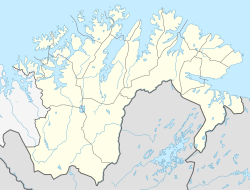Karasjok (village)
|
Karasjok Kárášjohka |
|
|---|---|
| Village | |

View of the historic church in the village
|
|
| Location in Finnmark | |
| Coordinates: 69°28′18″N 25°30′40″E / 69.47167°N 25.51111°ECoordinates: 69°28′18″N 25°30′40″E / 69.47167°N 25.51111°E | |
| Country | Norway |
| Region | Northern Norway |
| County | Finnmark |
| District | Vest-Finnmark |
| Municipality | Karasjok |
| Area | |
| • Total | 2.22 km2 (0.86 sq mi) |
| Elevation | 141 m (463 ft) |
| Population (2013) | |
| • Total | 1,858 |
| • Density | 837/km2 (2,170/sq mi) |
| Time zone | CET (UTC+01:00) |
| • Summer (DST) | CEST (UTC+02:00) |
| Post Code | 9730 Karasjok |
Karasjok (Norwegian) or Kárášjohka (Northern Sami) is the administrative centre of Karasjok Municipality in Finnmark county, Norway. The village is located along both sides of the Karasjohka river, just 12 kilometres (7.5 mi) west of the Norway-Finland border. The European route E06 highway runs through the village on its way from Lakselv to Tana bru and Kirkenes. The 2.22-square-kilometre (550-acre) village has a population (2013) of 1,858, which gives the village a population density of 837 inhabitants per square kilometre (2,170/sq mi).
The village is an important centre in the municipality and region. About 2/3 of the municipal population lives in the village. The Sami Parliament of Norway is located in the village. It acts as an institution of cultural autonomy for the indigenous Sami people in Norway. The Old Karasjok Church and the newer Karasjok Church are located in the village. The newer church is also the seat of the Indre Finnmark deanery of the Church of Norway.
Prior to the beginnig of the 1700s, there might not have been a permanent population there. However the area was used by nomads.
During World War II a Nazi concentration camp was built in Karasjok: Lager IV Karasjok (German for "Karasjok Camp No.4", Norwegian: Karasjok fangeleir). The camp was run by SS, and it was among the first four Nazi concentration camps in Northern Norway.
...
Wikipedia


